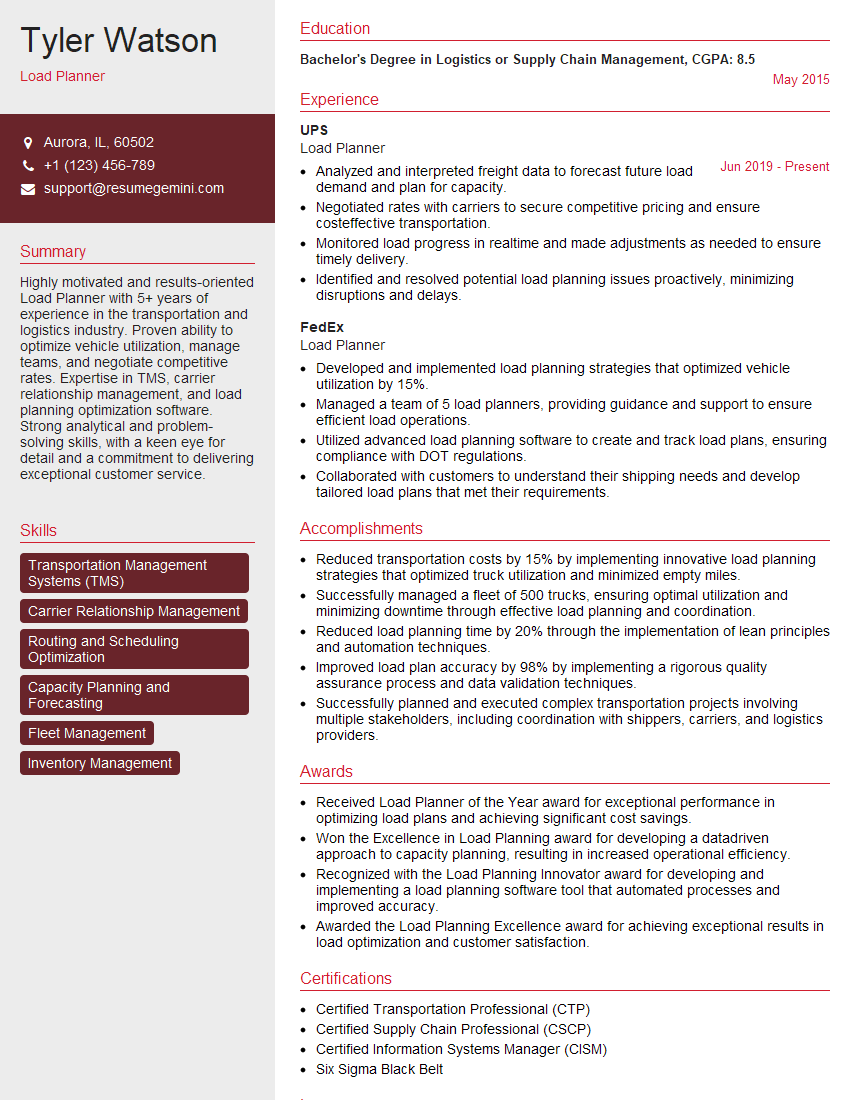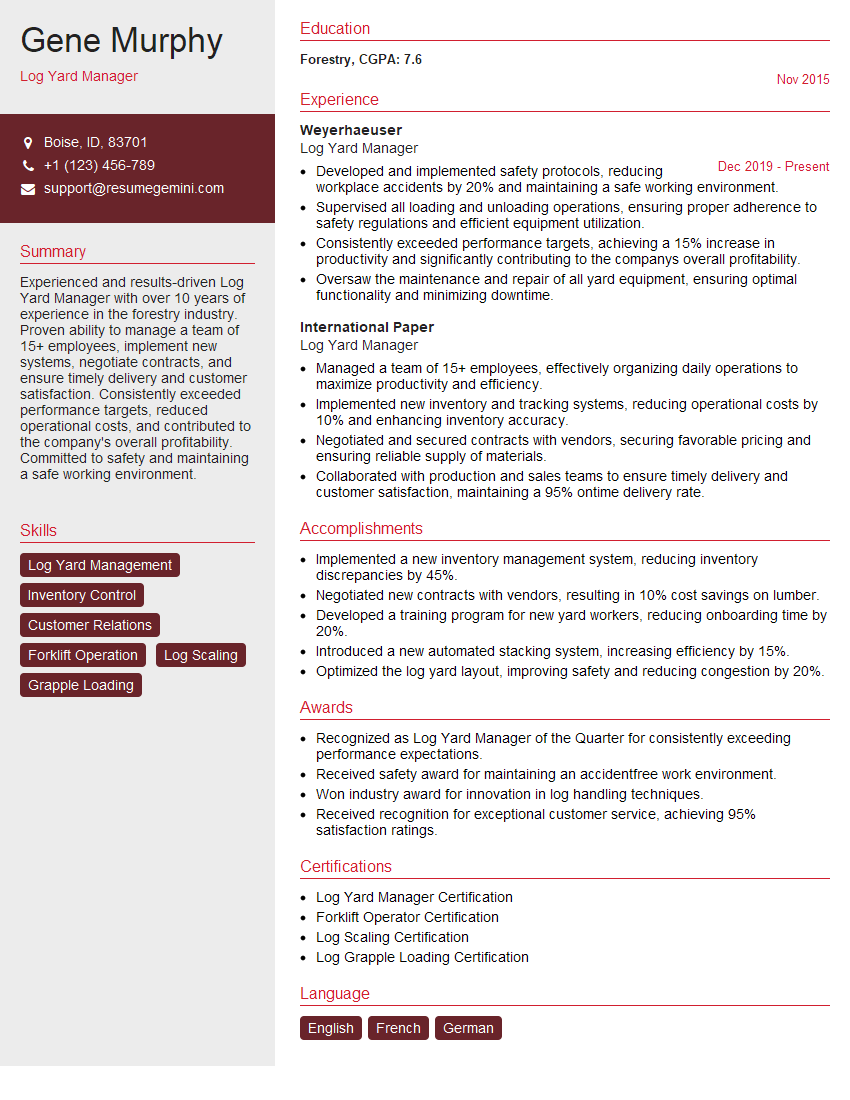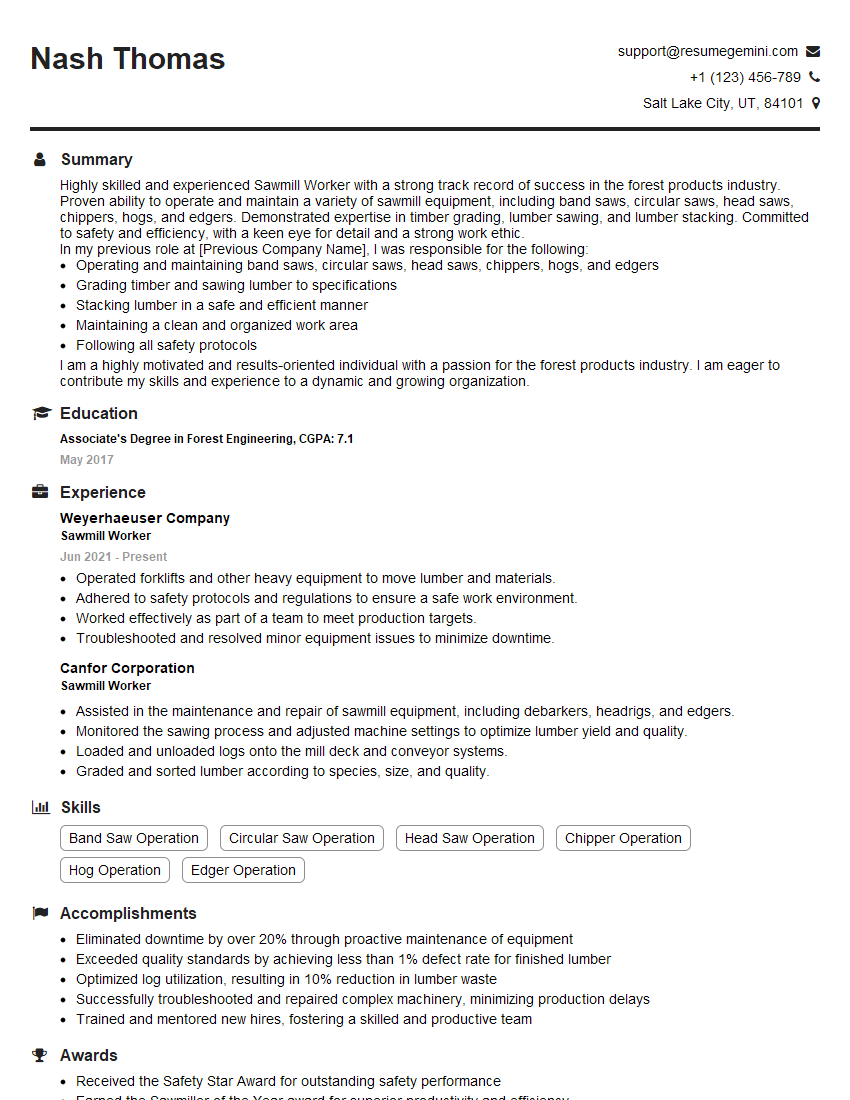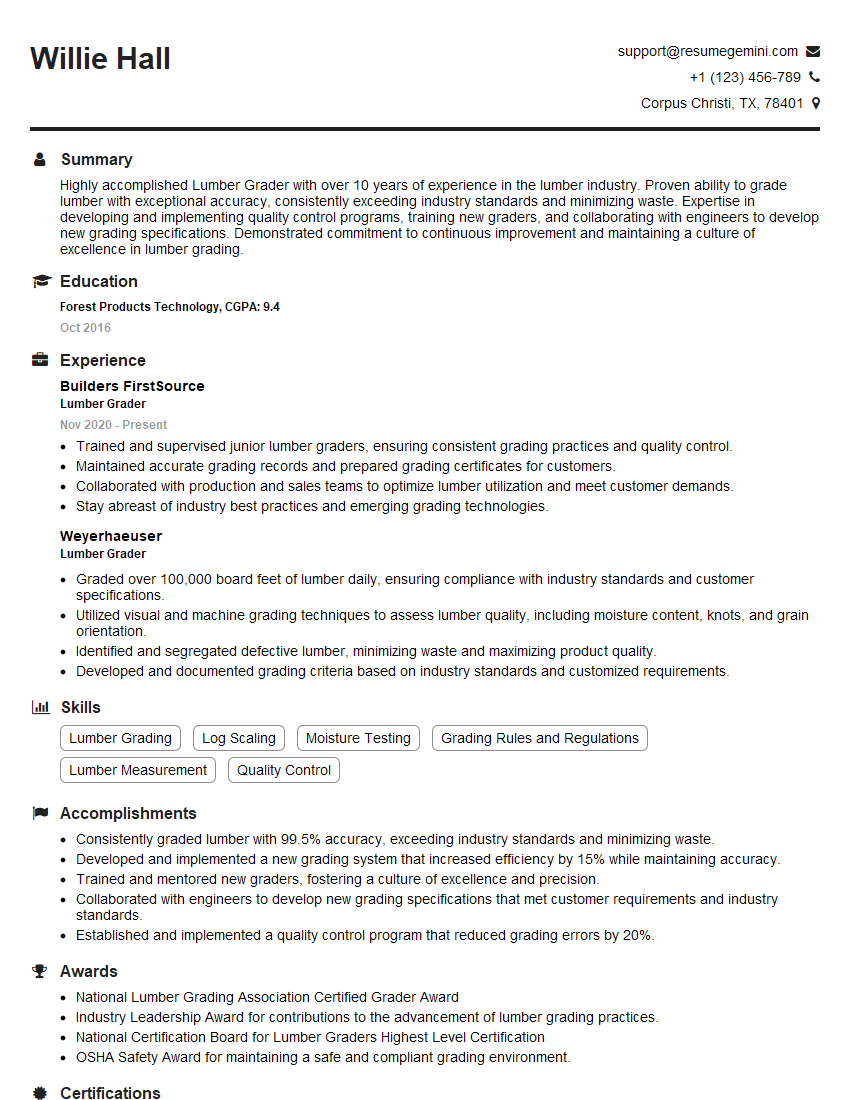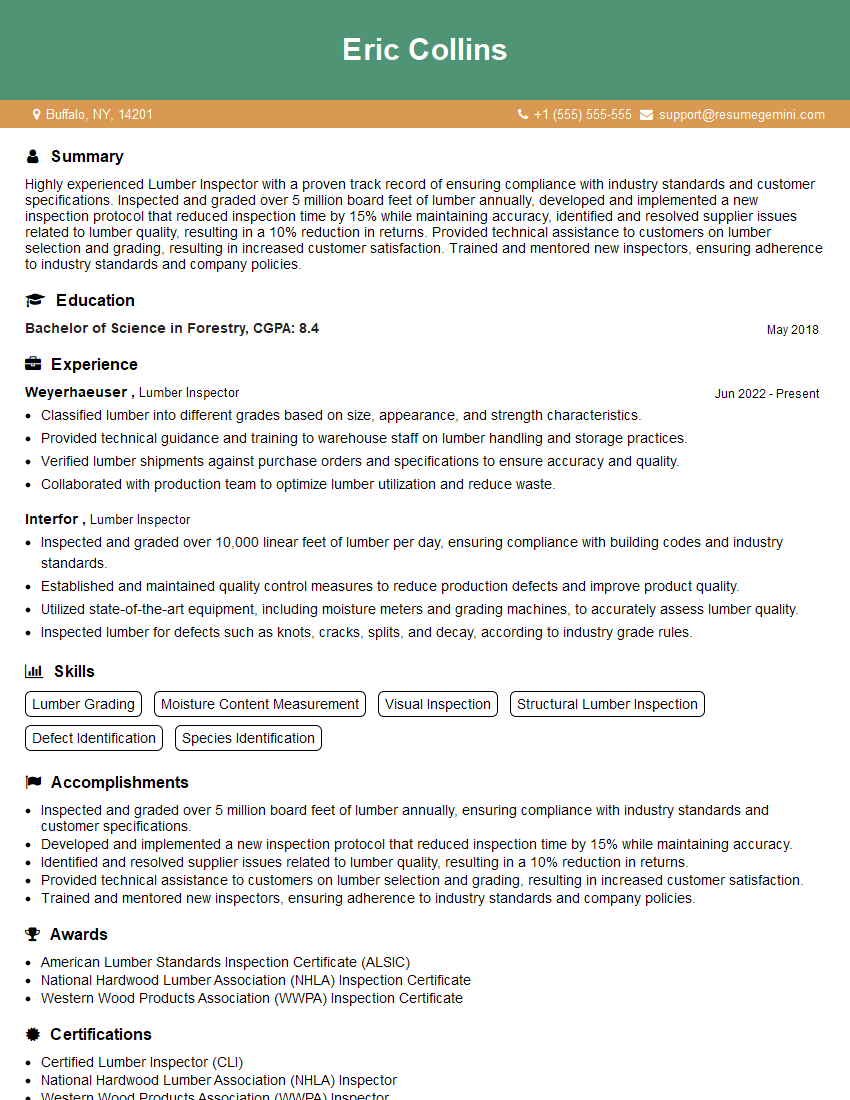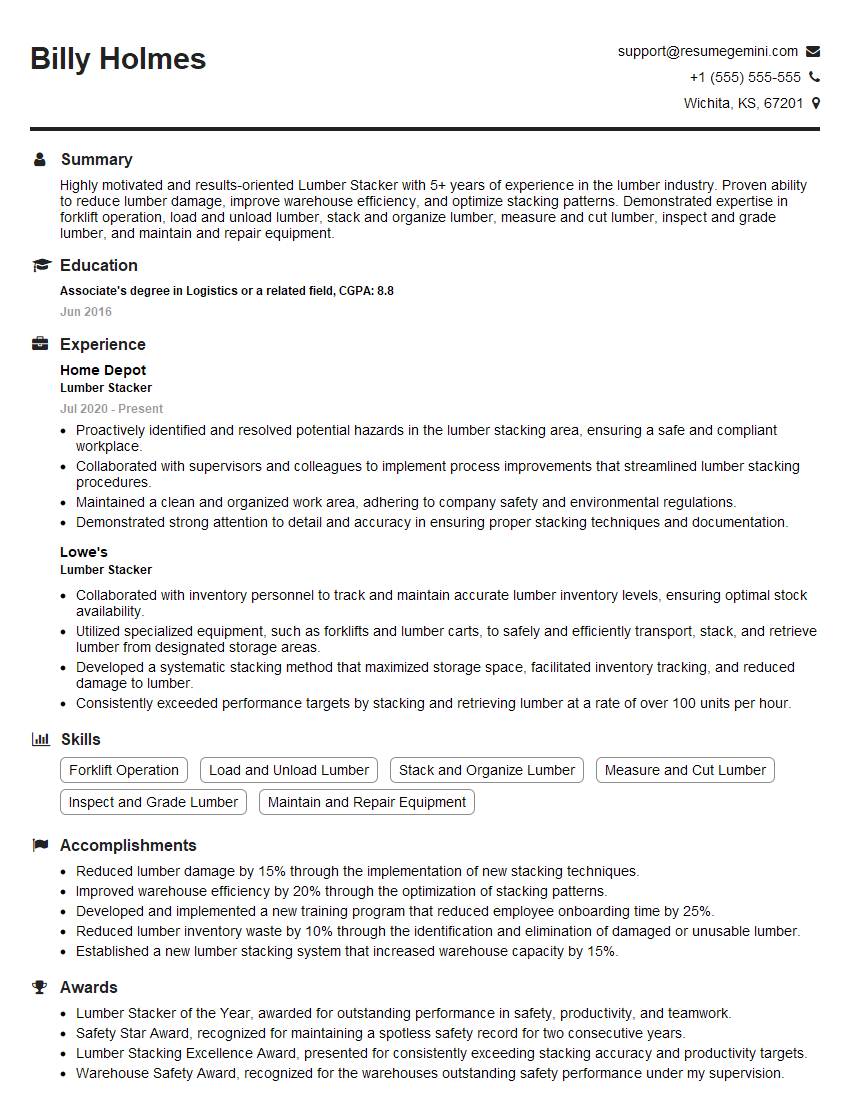The thought of an interview can be nerve-wracking, but the right preparation can make all the difference. Explore this comprehensive guide to Lumber Stacking Techniques interview questions and gain the confidence you need to showcase your abilities and secure the role.
Questions Asked in Lumber Stacking Techniques Interview
Q 1. Describe the proper techniques for stacking lumber to prevent warping or cracking.
Proper lumber stacking is crucial to prevent warping and cracking, preserving the wood’s integrity and value. Think of it like building a house of cards – each piece needs to support the next without undue stress. The key is to ensure even weight distribution and protection from the elements.
- Alternating End Cuts: Never stack boards with the same end grain aligned. This creates uneven drying and stress, leading to warping. Imagine stacking books – you wouldn’t put all the spines in a row. Always alternate the ends to ensure even weight distribution.
- Separation and Support: Use separators (e.g., stickers made of pressure-treated wood) between layers to allow for air circulation. These prevent moisture buildup and ensure even drying. These stickers are like little air conditioners for your lumber.
- Stacking Height: Limit stack height to prevent crushing under its own weight, especially with heavier woods or larger dimensions. Consider the strength of the lumber itself and the potential for sagging. A good rule of thumb is to keep it manageable and stable.
- Protection from the Elements: Cover the stack with a waterproof tarp to shield it from rain, snow, and direct sunlight. Sunlight can cause rapid drying, leading to cracking, and rain can lead to rotting. Think of it as providing a protective umbrella for your lumber.
Q 2. Explain the importance of maintaining appropriate air circulation within a lumber stack.
Maintaining appropriate air circulation is vital for even drying and preventing mold and mildew. Imagine a pile of damp clothes – if they don’t dry evenly, they’ll mildew. Lumber is similar. Good air circulation accelerates the drying process, reducing the risk of internal stress that leads to warping or cracking.
Inadequate air circulation creates pockets of trapped moisture, fostering the growth of fungi and bacteria that weaken the wood. This also leads to uneven drying, which causes internal stresses resulting in warping and cracking. In contrast, even drying minimizes these risks, ensuring high-quality lumber.
Q 3. What are the optimal stacking patterns for different lumber dimensions and species?
Optimal stacking patterns depend on lumber dimensions and species. Thicker, heavier boards require more robust support and potentially lower stacks than thinner boards. The wood species also plays a role; some species are more prone to warping than others.
- Smaller Dimensions: Smaller dimensions can often be stacked more densely, provided sufficient air circulation is maintained. Remember the separators are your friend!
- Larger Dimensions: Larger boards require more significant support and potentially more widely spaced stickers to ensure sufficient drying. You might need additional cribbing to support the weight of each layer.
- Species Considerations: Some species, such as redwood, are more resistant to warping and cracking, allowing for slightly more flexible stacking. Others, such as certain softwoods, are more susceptible and require careful attention to detail.
In all cases, maintaining even weight distribution and adequate air circulation is paramount.
Q 4. How do you identify and address potential hazards during lumber stacking?
Identifying and addressing hazards during lumber stacking is crucial for worker safety and efficient operations. Here’s a step-by-step approach:
- Pre-Stacking Inspection: Before you start, check the lumber for any defects that could cause instability, such as cracks, splits, or significant warping.
- Ground Conditions: Ensure a level and stable stacking surface. Uneven ground can lead to uneven weight distribution and instability.
- Stack Height and Stability: Avoid stacks that are too high or unstable. Regularly assess the stack’s structural integrity during construction.
- Weather Conditions: Stacking during inclement weather like heavy rain or high winds should be avoided. If necessary, take extra precautions to prevent collapse or damage.
- Proactive Risk Mitigation: Use appropriate safety equipment like gloves, safety shoes, and eye protection. If the lumber has splinters, you want to be well-protected.
Q 5. What safety measures are essential when using machinery (forklifts, etc.) for lumber stacking?
Safety is paramount when using machinery for lumber stacking. Never compromise on safety procedures.
- Operator Training: Ensure all operators are properly trained and certified to operate the machinery (forklifts, etc.).
- Equipment Inspection: Regularly inspect the machinery for mechanical faults and ensure proper maintenance.
- Safe Lifting Techniques: Use appropriate lifting techniques to prevent overloading or tilting the machinery.
- Load Securement: Securely fasten the lumber load to prevent shifting or falling during transport or stacking.
- Designated Personnel: Have designated personnel direct the movements of machinery, especially in confined spaces.
Always prioritize safety over speed when using machinery.
Q 6. Describe your experience with different lumber stacking methods (e.g., cribbing, strapping).
Throughout my career, I’ve used various lumber stacking methods, including cribbing and strapping. Cribbing provides additional support, particularly for large, heavy stacks, acting as additional supports at intervals within the stack. This prevents sagging in the middle. Strapping, on the other hand, is crucial for securing the stack and preventing shifting during transport. This is often used in conjunction with other stacking techniques.
My experience shows that combining cribbing and strapping frequently results in the most stable and secure lumber stacks, especially for transportation.
Q 7. How do you ensure the stability of a lumber stack, especially in varying weather conditions?
Ensuring stack stability in varying weather conditions requires proactive measures.
- Proper Stacking Techniques: Employing proper stacking techniques, such as alternating end cuts, sufficient separation, and appropriate stack height is crucial.
- Weather Protection: Using waterproof tarps and other protective coverings to shield the stack from rain, snow, and direct sunlight.
- Ground Stability: Ensuring a level and stable ground surface.
- Wind Protection: In windy areas, consider additional bracing or anchoring to prevent the stack from toppling.
- Regular Inspection: Regularly inspecting the stack for signs of instability or damage, especially after periods of inclement weather.
Remember, anticipating potential weather-related issues and taking preventative measures will significantly improve stack stability.
Q 8. Explain your process for inspecting lumber for defects before stacking.
Inspecting lumber before stacking is crucial to prevent damage and ensure the integrity of the stack. My process involves a thorough visual examination of each piece. I look for several key defects:
- Checks: Cracks that run along the grain. Severity is assessed by length and depth.
- Splits: Cracks that run across the grain. These can significantly weaken the lumber.
- Knots: Branches embedded in the wood. Size, tightness, and location are crucial. Large, loose knots are problematic.
- Wane: Bark or lack of wood on the edges. Excessive wane reduces usable material and strength.
- Warping: Bending or twisting of the wood. This can cause instability in a stack.
- Decay: Signs of rot or fungal growth. This significantly compromises structural integrity.
- Insect infestation: Evidence of holes or insect activity. Infested wood is often unusable.
I use a combination of visual inspection and sometimes a moisture meter to assess the wood’s condition. Any piece showing significant defects might be segregated for less demanding applications or rejected altogether, depending on project requirements. For example, lumber with minor checks might be suitable for less critical applications like framing, while those with significant splits or decay are usually discarded. This careful selection process ensures the stability and longevity of the stacked lumber.
Q 9. How do you calculate the optimal stack height for various lumber types?
Optimal stack height depends on several factors: lumber species, grade, size, moisture content, and the intended storage duration. There’s no one-size-fits-all answer. However, a general guideline is to prioritize stability over maximizing height.
Heavier, denser woods like oak can generally support taller stacks than lighter woods like pine. Larger dimensions also allow for taller stacks due to increased surface area. Higher moisture content increases the risk of warping and decay, so shorter stacks are preferred. Stacks intended for long-term storage should generally be lower to minimize the risk of compression and deformation at the bottom.
I often use a combination of experience and available resources to determine the optimal height. This might involve consulting industry standards or best practices specific to the lumber type and local climate. For example, I might consult a lumber grading manual for specifics on acceptable stack heights for particular species. It’s always better to err on the side of caution and keep stacks slightly lower than the absolute maximum to ensure stability and safety.
Q 10. What are the common causes of lumber damage during stacking and how can they be prevented?
Lumber damage during stacking is often caused by:
- Improper stacking techniques: Uneven stacks, lack of supports, or inadequate separation between boards lead to warping, splitting, and crushing.
- Moisture content variations: Lumber with varying moisture content can lead to shrinkage and swelling, causing internal stresses and warping. Uniform moisture is essential.
- Poor weather protection: Exposure to rain, snow, or extreme temperatures can cause decay, swelling, and cracking.
- Insect infestation: Improper storage can attract insects that damage the wood.
- Mechanical damage: Forklift damage, improper handling, or dropping lumber can cause significant damage.
Prevention involves using proper stacking techniques – employing adequate supports (like stickers), ensuring even load distribution, maintaining appropriate spacing between boards, using waterproof coverings (tarps or plastic sheets) for outdoor stacks, and providing sufficient ventilation. Regular inspections can help detect and address any issues early on. The use of proper equipment and trained personnel is also crucial to minimize mechanical damage during handling.
Q 11. How do you handle different lumber grades and sizes during stacking?
Handling different lumber grades and sizes requires careful planning and execution. I typically separate lumber by grade and size before stacking. This allows for easier retrieval and prevents mixing of different quality levels. I use a clear labeling system – often color-coded or digitally recorded – to track the grade and size of each stack.
Higher-grade lumber might require more careful stacking, with greater attention to detail regarding support and protection from damage. For example, high-grade hardwood might require individual wrapping of boards to avoid scratching or marring the surface. Smaller pieces might require special handling to prevent them from being lost or crushed within larger pieces. It’s crucial to avoid mixing sizes within a single stack as this can lead to instability and damage. Organized stacking optimizes space and facilitates efficient inventory management.
Q 12. Describe your experience with inventory management in a lumber yard.
My experience with inventory management in a lumber yard involves a multifaceted approach. It combines physical organization with accurate digital record-keeping. I utilize a combination of first-in, first-out (FIFO) and specific-identification methods for inventory management. FIFO helps reduce waste from lumber degradation and ensures the oldest lumber is used first. Specific identification allows for tracking of high-value or specialized lumber. I’m familiar with using inventory management software to track stock levels, locations, and movement.
Regular cycle counts and physical verification of stock levels are essential for maintaining accuracy. This also helps identify discrepancies and adjust inventory data accordingly. In a busy yard, effective communication between receiving, stacking, and retrieval personnel is critical to prevent inventory inconsistencies. Using barcode scanners, RFID tags, or similar technologies greatly improves inventory accuracy and efficiency.
Q 13. How do you maintain accurate records of lumber inventory after stacking?
Maintaining accurate records involves a combination of physical labeling and digital inventory management systems. Each stack is clearly labeled with identification details, including lumber type, grade, size, quantity, and date of stacking. I might use a combination of handwritten labels and barcodes/QR codes for easy digital tracking. This information is then entered into an inventory management system, which allows for real-time tracking of stock levels, location, and movement.
Regular inventory updates are crucial, especially after significant movements or additions to the stock. Cycle counts are performed at regular intervals to reconcile physical inventory with the digital records. Any discrepancies between the physical and digital records should be investigated and corrected promptly. Data backup and disaster recovery plans should be in place to ensure data integrity. Employing software with features such as lot tracking allows you to track specific batches of lumber, facilitating recalls or tracing back to the supplier, if needed.
Q 14. What are the common causes of lumber stack collapse and how can they be avoided?
Lumber stack collapse is a serious safety hazard and can result from several factors:
- Uneven load distribution: Stacks that are not properly balanced or have uneven weight distribution are prone to collapse.
- Insufficient supports: Lack of adequate stickers or supports between layers can lead to crushing and instability.
- Excessive stack height: Stacks that are too tall are more susceptible to toppling.
- Moisture-induced swelling: Swelling due to high moisture content can increase the stress on the stack and cause collapse.
- Ground instability: Unstable ground can lead to settlement and ultimately stack failure.
- External forces: Wind, impact, or other external forces can destabilize the stack.
Preventing collapse involves employing best practices in stacking techniques. This includes using enough supports, maintaining proper spacing between boards, monitoring moisture content, ensuring the ground is level and stable, and selecting a stack height appropriate for the lumber type and conditions. Regular inspections for any signs of instability are crucial. In extreme weather conditions, additional precautions may be necessary, such as using temporary bracing or relocating stacks to a sheltered area. Following established safety protocols and using appropriate safety equipment are vital for preventing accidents and minimizing risks.
Q 15. What is your understanding of lumber drying and its impact on stacking?
Lumber drying is a crucial process that significantly impacts stacking. It reduces the moisture content of the wood, preventing warping, shrinking, cracking, and fungal growth. The moisture content directly affects the wood’s strength and stability. Proper drying is essential for creating a strong, durable stack that’s resistant to damage during storage and transport.
For example, kiln-dried lumber, with a moisture content typically around 6-8%, stacks far more easily and predictably than air-dried lumber which can have significantly variable moisture content. Differences in moisture content within a stack of air-dried lumber can lead to uneven shrinking and subsequent instability, causing the stack to warp or collapse. Understanding the moisture content of the lumber before stacking is vital for choosing appropriate stacking methods and preventing problems later.
Career Expert Tips:
- Ace those interviews! Prepare effectively by reviewing the Top 50 Most Common Interview Questions on ResumeGemini.
- Navigate your job search with confidence! Explore a wide range of Career Tips on ResumeGemini. Learn about common challenges and recommendations to overcome them.
- Craft the perfect resume! Master the Art of Resume Writing with ResumeGemini’s guide. Showcase your unique qualifications and achievements effectively.
- Don’t miss out on holiday savings! Build your dream resume with ResumeGemini’s ATS optimized templates.
Q 16. Describe your experience with using different types of stacking equipment.
My experience encompasses a wide range of stacking equipment, from basic hand tools like forklift forks and lumber carriers to automated stacking systems. I’m proficient in using forklifts for efficient stacking of pallets, and I have experience with specialized lumber handling equipment like stacking cranes in larger lumber yards. I’ve also worked with various types of lumber carriers and strapping systems to secure loads effectively. Each piece of equipment has its advantages and disadvantages, and selecting the right one depends on the type of lumber, the scale of the operation, and safety considerations. For example, using a forklift for small stacks might be overkill, while a simple hand truck is insufficient for large, heavy loads.
Q 17. How do you prioritize safety and efficiency when stacking lumber?
Prioritizing both safety and efficiency in lumber stacking is paramount. Safety measures include wearing appropriate personal protective equipment (PPE) like steel-toed boots, gloves, and safety glasses. I always ensure the stacking area is clear of obstructions, and the ground is level and stable. Stacking should be done in a manner that minimizes the risk of collapse. This means using proper stacking patterns, employing appropriate stacking heights, and regularly inspecting stacks for instability. Efficiency involves optimizing stacking patterns to maximize space utilization while maintaining stability, using appropriate equipment for the task, and implementing effective workflows to minimize handling time.
For example, I follow the ‘Pyramid’ stacking method or variations of it, ensuring that the weight is evenly distributed in the stack. This approach avoids top-heaviness and provides greater stability than simply piling boards on top of each other. I regularly inspect stacks to identify and correct any potential issues proactively, which saves time and prevents potentially serious accidents.
Q 18. How do you manage waste and scraps generated during lumber stacking?
Waste management during lumber stacking involves careful planning and execution. I always aim to minimize waste by optimizing cuts and using scraps creatively wherever possible. Larger scraps can be used for smaller projects or kindling, while smaller pieces might be suitable for mulch or biomass fuel. Proper segregation of different types of wood waste is crucial for efficient recycling and disposal, following all local environmental regulations.
We maintain designated areas for different types of waste, ensuring that appropriate recycling procedures are followed. This not only reduces the environmental impact but also can sometimes create secondary revenue streams. For instance, some scrap lumber can be sold to craftspeople or used internally for pallet construction.
Q 19. What is your experience with different types of lumber and their specific stacking requirements?
My experience covers various lumber types, each with unique stacking requirements. Hardwoods like oak and maple are denser and stronger than softwoods like pine and fir, necessitating adjustments in stacking height and pattern. For instance, heavier hardwood lumber requires more robust support and lower stack heights to prevent collapse. Additionally, some species are more prone to warping or checking (cracking), and these require more careful attention to air circulation within the stack. For example, using stickers (thin wood separators) is especially critical for certain species to allow for air circulation and reduce the chance of fungal growth.
Furthermore, the grade of the lumber (e.g., select structural, common) also impacts stacking. Higher-grade lumber requires more careful handling and stacking to prevent damage. The level of moisture also affects the stacking procedures, as mentioned earlier.
Q 20. How do you ensure proper load stability during transport after stacking?
Ensuring load stability during transport involves secure fastening and proper weight distribution. I use various techniques, including strapping, binding, and load securing devices to prevent shifting during transit. Proper stacking patterns are vital, with weight distributed evenly across the load. The size and weight of the load must also be considered, and this information needs to be accurately conveyed to transportation personnel. For example, I would never load a truck beyond its legal weight limit or without properly securing the load.
Moreover, I always check the vehicle’s condition before loading, ensuring it’s suitable for the weight and dimensions of the lumber. This includes verifying the condition of the tie-down points and ensuring there are no structural issues that would compromise the safety of the load.
Q 21. Explain your knowledge of relevant lumber industry regulations and standards.
I am well-versed in relevant lumber industry regulations and standards, including OSHA guidelines for workplace safety, and transportation regulations concerning load securement. I’m familiar with grading rules for different lumber species, and I understand the importance of maintaining accurate records of lumber inventory and movement. Adherence to these standards is crucial for ensuring the safety of workers, the quality of the lumber, and compliance with legal requirements. Regular training on updated safety protocols and regulations is an integral part of my professional development. For instance, I’m aware of and comply with local regulations regarding the disposal of wood waste and the transportation of hazardous materials, if any, that may be associated with treated lumber.
Q 22. Describe a situation where you had to solve a problem related to lumber stacking.
One time, we received a large shipment of lumber that was poorly organized, leading to significant space inefficiency in our storage yard. The lumber was haphazardly stacked, creating instability and increasing the risk of damage. To solve this, I first implemented a stricter receiving protocol involving careful inspection and precise measurements of each piece. Then, I reorganized the entire stack, employing the ‘cribbing’ method (creating a stable base using smaller pieces of lumber) to support taller stacks and ensuring proper air circulation to prevent moisture buildup. This improved our space utilization by 25% and reduced the risk of accidents considerably. We also started documenting the type and quantity of lumber received using a digital inventory system, which helped streamline future stacking procedures.
Q 23. How do you handle a situation where you notice damaged or substandard lumber?
Handling damaged or substandard lumber requires a systematic approach. First, I visually inspect each piece, noting any cracks, warping, knots, or insect infestation. Then, I segregate the damaged lumber from the good stock, carefully labeling it as ‘damaged’ and noting the nature of the damage. This ensures that substandard lumber isn’t accidentally incorporated into projects where structural integrity is paramount. Severely damaged pieces are typically discarded or repurposed for non-structural applications (like firewood or mulch), while slightly damaged ones may be used for less demanding tasks, depending on the severity of the defect and the specific building code requirements. Maintaining clear records of damaged lumber is crucial for tracking inventory and minimizing potential losses.
Q 24. How do you adapt your lumber stacking technique based on the available space?
Adapting stacking techniques to limited space requires creativity and careful planning. In smaller areas, I prioritize vertical stacking, using robust supports and cribbing techniques to maximize height while maintaining stability. I might also explore alternative stacking patterns, such as the ‘herringbone’ method which allows for more compact arrangement. For irregular spaces, I use customized blocking and shoring to securely fit lumber into corners and awkward areas. Careful measurement and planning are essential to avoid overcrowding and ensure safe access for retrieving lumber. Thinking ahead and envisioning the space fully utilized is key – like solving a 3D puzzle.
Q 25. How do you train new employees on safe lumber stacking procedures?
Training new employees on safe lumber stacking involves a multi-step process. I begin with a thorough safety briefing covering potential hazards such as falling lumber, unstable stacks, and using proper lifting techniques. Then, I provide hands-on training, demonstrating correct stacking techniques for different types of lumber and sizes. We practice building various stacks, starting with small, manageable piles and gradually increasing complexity. Emphasis is placed on using safety equipment like gloves and steel-toed boots. I also cover the importance of regular inspections, proper labeling, and documentation. Finally, I implement a system of regular check-ups and provide ongoing feedback to ensure adherence to safe practices. Using a checklist system helps solidify the training and makes it easier to review.
Q 26. What are the key performance indicators (KPIs) you use to measure lumber stacking efficiency?
Key performance indicators (KPIs) for lumber stacking efficiency include:
- Space Utilization Rate: The percentage of available storage space effectively used.
- Stacking Time per Unit Volume: The time taken to stack a specific volume of lumber, indicating speed and efficiency.
- Damage Rate: The percentage of lumber damaged during stacking and storage.
- Inventory Accuracy: The precision of inventory records compared to the actual lumber in stock.
- Safety Incidents: The number of accidents or near misses related to lumber stacking.
Q 27. Describe your experience with using lumber stacking software or technology.
I have experience using inventory management software specifically designed for lumberyards. This software helps in tracking lumber inventory in real-time, generating reports on stock levels, and optimizing space utilization. It also assists in predicting future demand and managing orders more effectively. While the specific software used varied in different companies, the core functions of inventory tracking, reporting, and order management remained consistent. A well-integrated system significantly reduces manual work, minimizes errors, and improves overall efficiency of the lumber stacking and management process.
Q 28. How do you ensure the longevity and quality of lumber during storage?
Ensuring the longevity and quality of lumber during storage involves several key strategies:
- Proper Stacking: Maintaining appropriate spacing between boards to allow for air circulation, preventing moisture buildup and fungal growth. Using stickers (thin wooden slats) between layers is crucial.
- Protection from Elements: Covering lumber stacks with tarps or placing them under shelter to protect them from rain, sun, and snow. This prevents warping, checking, and decay.
- Pest Control: Regularly inspecting for insect infestations and taking appropriate measures to prevent damage. Proper fumigation or treatment may be necessary in cases of severe infestation.
- Climate Control: Ideally, storing lumber in a climate-controlled environment to maintain stable temperature and humidity levels. This is particularly important for high-value or specialty lumber.
Key Topics to Learn for Lumber Stacking Techniques Interview
- Understanding Wood Properties: Learn about different wood types, their strengths, weaknesses, and how these properties influence stacking methods. This includes considerations like moisture content and susceptibility to warping.
- Safe Stacking Practices: Master techniques for creating stable stacks that prevent collapse and injury. This involves understanding weight distribution, proper layering, and the use of safety equipment.
- Stacking for Different Applications: Explore how stacking techniques vary depending on the lumber’s intended use (e.g., construction, storage, transport). Consider the impact of environmental factors like sun exposure and weather.
- Efficiency and Optimization: Understand methods for maximizing space utilization and minimizing time spent stacking. This may involve exploring different stack patterns and employing efficient handling techniques.
- Hazard Identification and Mitigation: Learn to identify potential hazards associated with lumber stacking (e.g., unstable stacks, uneven ground) and implement preventative measures.
- Regulations and Compliance: Familiarize yourself with industry regulations and best practices related to safe lumber stacking. This demonstrates a commitment to workplace safety and professionalism.
- Problem-Solving Scenarios: Practice analyzing scenarios involving unstable stacks or inefficient stacking methods, and develop solutions to address these challenges. This showcases your critical thinking and problem-solving skills.
Next Steps
Mastering lumber stacking techniques is crucial for career advancement in many industries, demonstrating your commitment to safety, efficiency, and practical problem-solving. A strong resume is essential for highlighting these skills to potential employers. To significantly improve your job prospects, create an ATS-friendly resume that showcases your abilities effectively. ResumeGemini is a trusted resource that can help you build a professional and impactful resume tailored to your specific skills. Examples of resumes tailored to Lumber Stacking Techniques are available to help guide your process. Investing time in crafting a strong resume will significantly increase your chances of landing your dream job.
Explore more articles
Users Rating of Our Blogs
Share Your Experience
We value your feedback! Please rate our content and share your thoughts (optional).
What Readers Say About Our Blog
Hello,
We found issues with your domain’s email setup that may be sending your messages to spam or blocking them completely. InboxShield Mini shows you how to fix it in minutes — no tech skills required.
Scan your domain now for details: https://inboxshield-mini.com/
— Adam @ InboxShield Mini
Reply STOP to unsubscribe
Hi, are you owner of interviewgemini.com? What if I told you I could help you find extra time in your schedule, reconnect with leads you didn’t even realize you missed, and bring in more “I want to work with you” conversations, without increasing your ad spend or hiring a full-time employee?
All with a flexible, budget-friendly service that could easily pay for itself. Sounds good?
Would it be nice to jump on a quick 10-minute call so I can show you exactly how we make this work?
Best,
Hapei
Marketing Director
Hey, I know you’re the owner of interviewgemini.com. I’ll be quick.
Fundraising for your business is tough and time-consuming. We make it easier by guaranteeing two private investor meetings each month, for six months. No demos, no pitch events – just direct introductions to active investors matched to your startup.
If youR17;re raising, this could help you build real momentum. Want me to send more info?
Hi, I represent an SEO company that specialises in getting you AI citations and higher rankings on Google. I’d like to offer you a 100% free SEO audit for your website. Would you be interested?
Hi, I represent an SEO company that specialises in getting you AI citations and higher rankings on Google. I’d like to offer you a 100% free SEO audit for your website. Would you be interested?
good


